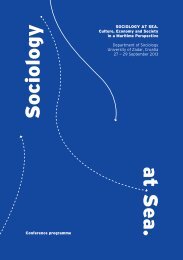rujan 2011. - Hrvatsko sociološko društvo
rujan 2011. - Hrvatsko sociološko društvo
rujan 2011. - Hrvatsko sociološko društvo
Create successful ePaper yourself
Turn your PDF publications into a flip-book with our unique Google optimized e-Paper software.
‣ Štulhofer, A. and Baćak, V. (2011). Is anal sex a marker for sexual risk taking? Results from a populationbased<br />
study of young Croatian adults. Sexual Health, 8(3): 384-389.<br />
http://apps.webofknowledge.com/full_record.do?product=WOS&search_mode=GeneralSearch&qid=4&SID=X1oF<br />
PApM7bBAcPio19I&page=2&doc=16&cacheurlFromRightClick=no<br />
Sažetak: There is evidence that anal sex is becoming increasingly popular among heterosexual women<br />
and men. A number of studies carried out in especially vulnerable populations (“high-risk groups”)<br />
suggested that anal sex may indicate a more general propensity to sexual risk taking. To assess whether<br />
this epidemiologically important finding holds in the case of young adults from the general population,<br />
we analyzed from a national probability study carried out in 2010 on 861 sexually experienced Croatian<br />
women and men aged 18-25. Anal intercourse was reported by 36.5% of participants. About one third of<br />
them (34%) used a condom at most recent anal intercourse. The experience of anal sex was significantly<br />
associated with all four indicators of sexual risk taking (condom use at most recent vaginal intercourse,<br />
number of sexual partners in the past year, concurrent sexual relationship, and anonymous sex in the past<br />
year), as well as with negative attitudes and beliefs about condom use. Sexual sensation seeking mediated<br />
the relationship between anal sex and some of the sexual risk-taking behaviors. According to the<br />
findings, heterosexual anal sex is directly and indirectly associated with increased behavioral risks of<br />
acquiring HIV and other STI. Sex education and HIV/STI prevention programs should focus on the<br />
importance of using protection when practicing anal sex.<br />
‣ Štulhofer, A., Ajduković, D (2011) “Should we take anodyspareunia seriously? A descriptive analysis of<br />
pain during receptive anal intercourse among young heterosexual women”. Journal of Sex and Marital<br />
Therapy, 37:346–358.<br />
http://bib.irb.hr/datoteka/529996.Anodyspareunia_JSMT_<strong>2011.</strong>pdf<br />
Sažetak: Anal sex is becoming increasingly prevalent among heterosexual women and men.<br />
Although pain related to receptive anal intercouse is not uncommon, little is known about its<br />
phenomenology. The article aims to assess the prevalence and correlates of pain during<br />
anoreceptive intercourse, including anodyspareunia, its most severe form, among young women. An<br />
online survey focusing on anal eroticism was carried out in March and April 2010 on a convenience<br />
sample of 2, 002 women 18-30 years of age. Participants who reported 2 or more episodes of anal<br />
intercourse in the past years were asked about the level and frequency of pain at anoreceptive<br />
penetration ; those who reported unbearable (too painful to continue) or strong pain at every such<br />
occasion were classified as anodyspareunic. The experience of anal intercouse was reported by<br />
63.2% (n=1, 265) of participants. Although almost half (48.8%) had to discontinue their first<br />
anoreceptive intercourse because of pain or discomfort, a majority of women (62.3% ; n=788)<br />
continued anal sex. Of the 505 participants who reported 2 or more episodes of anal intercourse in<br />
the past year, the women (8.7% ; n=44) who reported severe pain during every anoreceptive<br />
penetration were classified as non-anodyspareunic. For more than two thirds of women with<br />
anodyspareunia, the current pain level remained unchanged from their first experience with anal<br />
sex. Inability to relax was the most frequent self-hypothesized cause of pain among the<br />
anodyspareunic and nonanodyspareunic groups. Compared with other women, those with<br />
anodyspareunia reported substantially lower levels of sexual satisfaction (odds ratio=.95 ; p



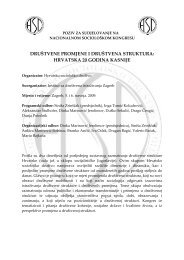

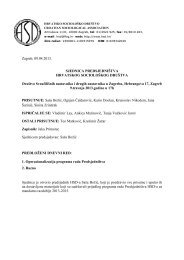
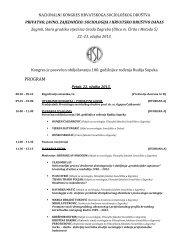

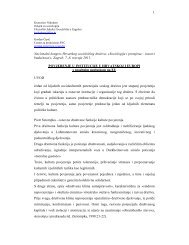
![PROGRAM SKUPA [pdf] - Hrvatsko sociološko društvo](https://img.yumpu.com/38770359/1/184x260/program-skupa-pdf-hrvatsko-socioloako-druatvo.jpg?quality=85)

